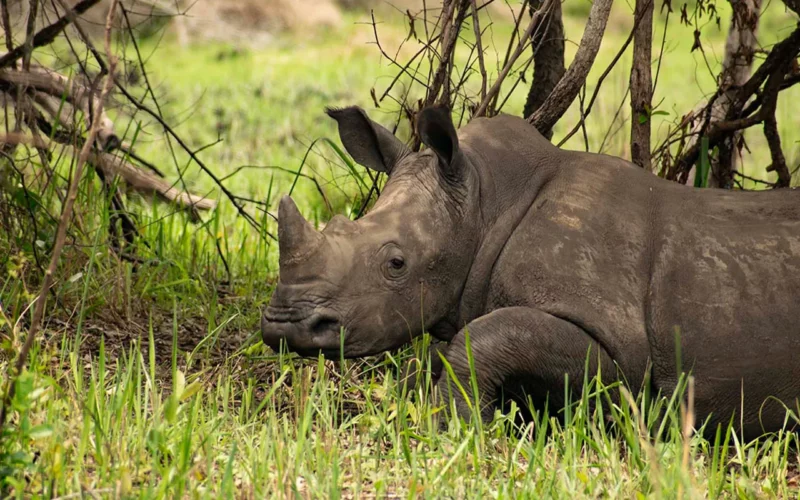Lying about 100 miles (1.5 hrs drive) along Gulu-Kampala highway, is a 70km2 Ziwa Rhino Sanctuary where the only population of rhinos in Uganda today thrives. At the sanctuary, an interpretive walking safari expereince up-close this African Big 5 member as it forages across this untamed wilderness habitat is a major highlight on any Uganda wildlife viewing safari.
Rhino History In Uganda
Historically, the northern white (Ceratotherium.s.cottoni) and black (Diceros biconis michalei) rhino species roamed abundantly across savanna grasslands of northern Uganda. Sadly from late 1960’s large fees paid by international trophy hunters and regional conflicts led to a hunting spree of these land giants till their local extinction at least in Uganda by 1983 when the last single individual was shot by the shores of River Nile in northern Uganda.
Fast forward in early 2005, an NGO with partnership from Uganda Wildlife Authority (UWA) began a breeding program in a 70 km 2 of wooded grasslands of Ziwa with a hope to re-introduce this specie of the Africa’s big 5 list in their former range in the near future. From that humble start of 4 southern white rhinos (Ceratotherium.s.simum) donated from Kenya and 2 from Disney World US, today the successful program is on track with numbers now at over 45 individuals and increasing!

Tracking Rhinos on Foot at Ziwa Sanctuary
At Ziwa rhino sanctuary, a 1-2hr guided nature walk in the wilderness brings you up-close and personal to the southern white rhinos that roam these grasslands. These guided nature walks are scheduled to time the most active times of rhinos as they forage. White rhinos are non aggressive (but wild), purely grazers and are not wholly solitary animals. Across their range, territorial bulls will often accept company from subordinate individuals while the adolescent males will socialise in small crushes. The female white rhinos are often in company of a recent offspring.
Along this guided walk, knowledgeable rangers will point out markings and tracks, share great insights about the social behavior of this second biggest land mammal including its ecological importance, while stressing the need to protect and support the survival of these species. On locating the rhinos, the rangers and visitor can only get as close as it is safe, for these are wild animals however the feeling of up close with these giants remains for a lifetime.
The wooded grasslands in the complex supports other local residents like, the elusive leopard seen on night patrols, Kob, beautiful and tame Bushbuck, Common Warthog, Vervet monkey and rich bird species checklist unique to these woodlands.
A way to Support the Conservation Program
Away from adventure and lifetime experience offered on the sanctuary, proceedings from gate entrances and fees are reinvested back into the breeding program of these species, while partnerships and individual support is highly encouraged.

Interesting facts to know about Rhinos
- Rhinos have weak eyesight (stretching up to 30m) but hearing and scent abilities is highly developed.
- Urine and dung serve to mark territories especially to bulls.
- Dung is deposited at maidens within home range of several residents, this is because dung at maidens concentrates and maintains smell better than randomly deposited dung, the scents are used to warn off potential rivals.
- Rhinos reproduction begins early from 3.5yrs-4 yrs where gestation is up to 16 months
- A group of rhinos is called a crush.
- Longevity is up to 35-50yrs.
Guidelines and dress code on a rhino guided nature walk at Ziwa Sanctuary
- On a visit to the sanctuary, GPS and other location apps MUST be switched off for the safety of these hunted species.
- While on a walk, adhere to safety guidelines and stay close to the ranger guide, these are wild animals and are unpredictable for this is for your safety.
- Dress casually in nature blending colors.
- Good walking shoes are recommended.
- Don’t use flash photography.
- Carry and use that hat and apply that sunscreen; it gets hot in the afternoon.
- Carry plenty of drinking water.
